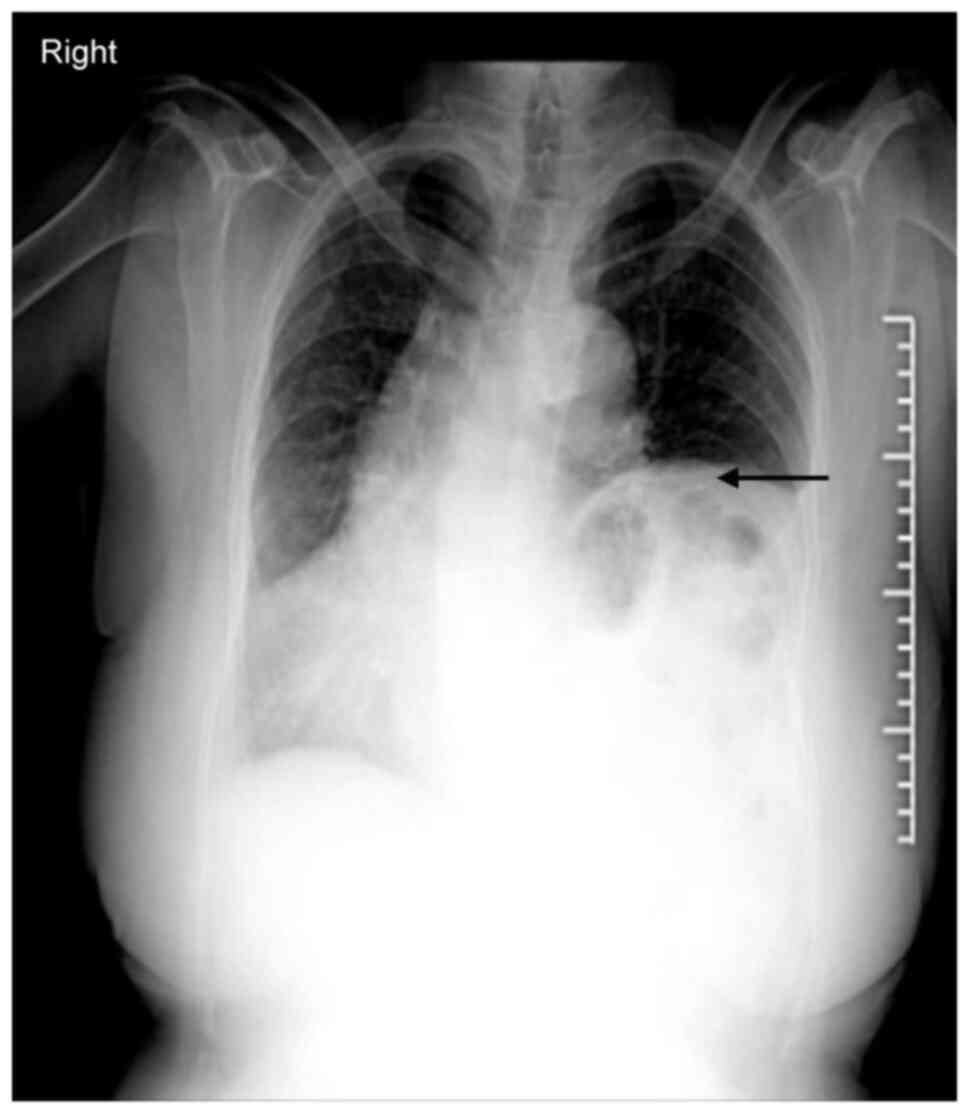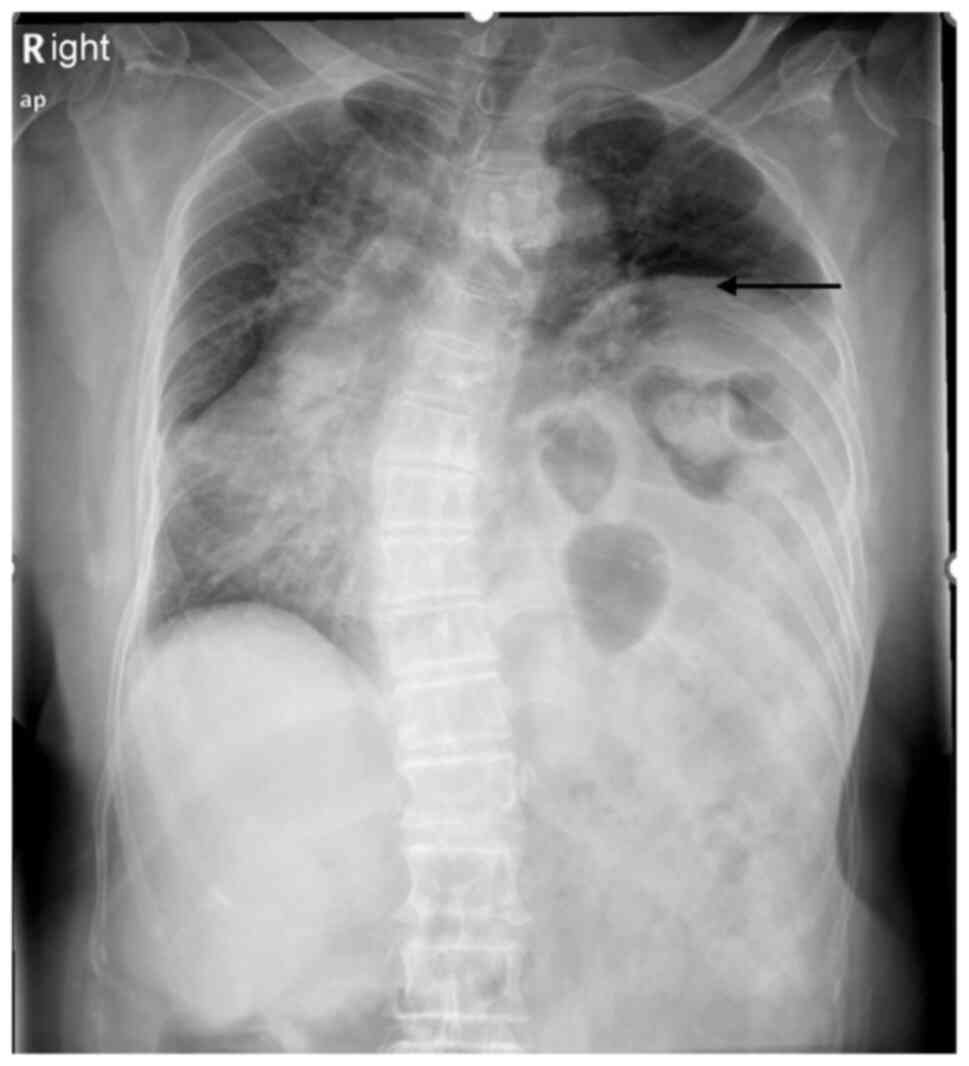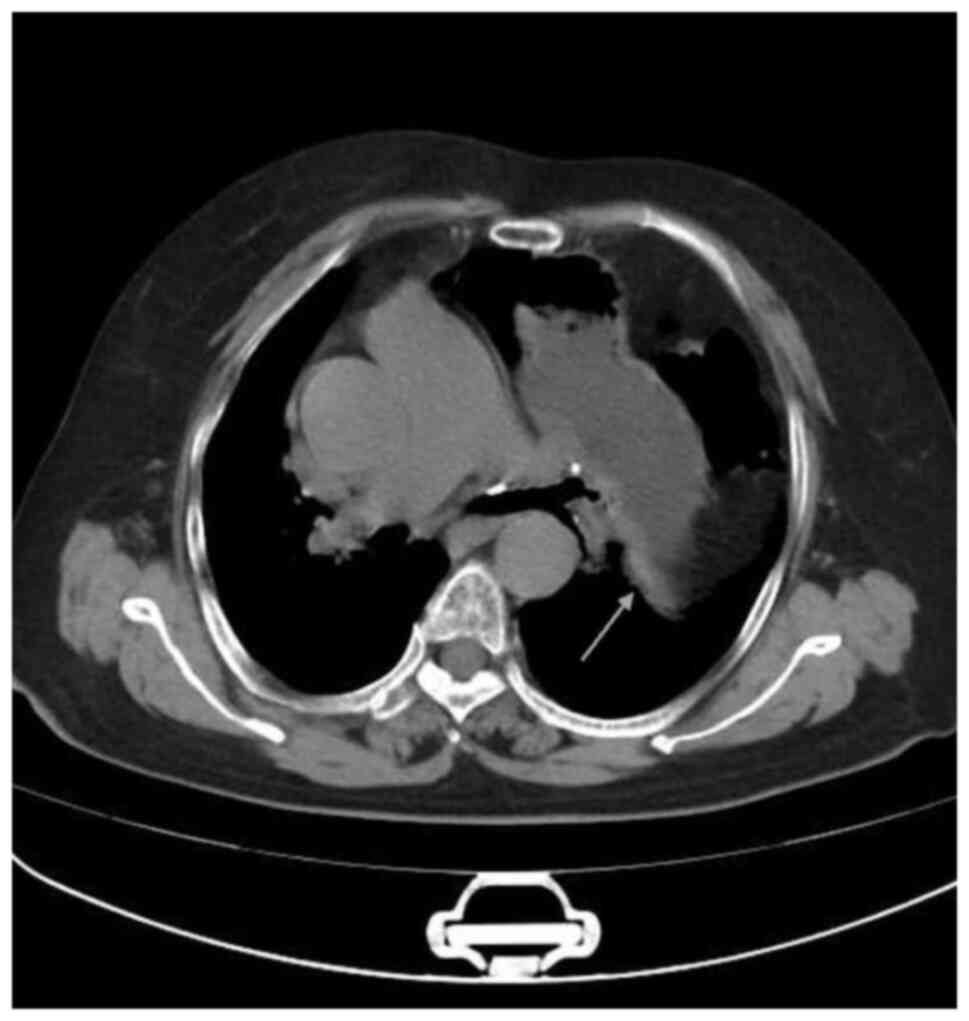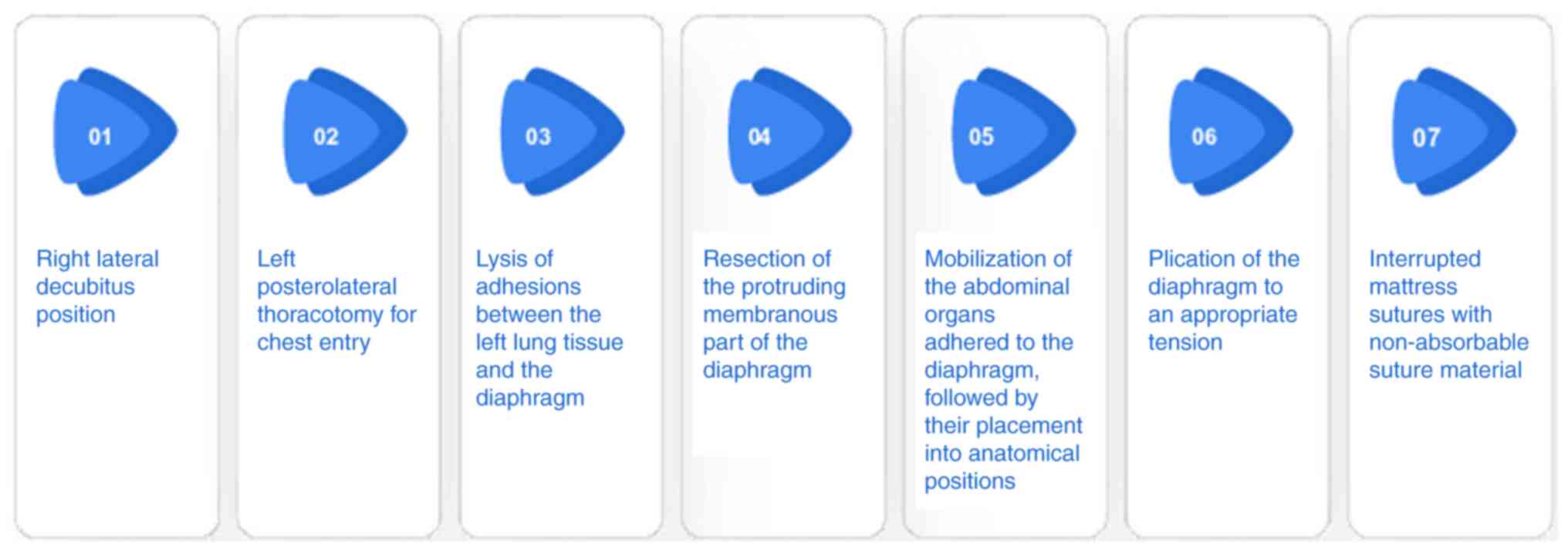SARS‑CoV‑2 infection exacerbates diaphragmatic eventration: A case report
- Authors:
- Published online on: August 27, 2024 https://doi.org/10.3892/br.2024.1845
- Article Number: 157
-
Copyright: © Xu et al. This is an open access article distributed under the terms of Creative Commons Attribution License.
Abstract
Introduction
Diaphragmatic eventration (DE) is a disorder characterized by diaphragmatic weakness, which is manifested by the abnormal elevation of the diaphragm due to muscle weakness and/or phrenic nerve trauma or injury (1). It most commonly occurs in children, particularly in infants; by contrast, the onset of DE in adults is relatively rare. Complete DE in adults is often an acquired condition and the symptoms vary between patients. Adult DE mostly occurs secondary to thoracic surgery or mechanical trauma, commonly due to phrenic nerve dysfunction or injury and muscle atrophy (1,2). The phrenic nerve provides motor and sensory innervation to the diaphragm, and any damage to this nerve can result in weakened diaphragmatic contractions, leading to elevation of the diaphragm (3). Muscle atrophy refers to the wasting away of muscle tissue, which can occur due to various reasons, such as disuse, disease or aging. When the diaphragmatic muscles undergo atrophy, they lose their strength and ability to maintain the normal position of the diaphragm, causing it to rise abnormally (4). In rare cases, DE has been associated with previous West Nile and dengue viral infections (5,6).
In the present study, the case of a patient with congenital localized DE that progressed to complete DE after infection with severe acute respiratory syndrome coronavirus 2 (SARS-CoV-2) is described, thus supporting the hypothesis that this virus could exacerbate DE progression. This finding suggested that SARS-CoV-2 may have a systemic effect that could exacerbate the symptoms and complications associated with DE. The systemic inflammatory response triggered by the virus could lead to additional muscle damage or nerve injury, worsening the condition of patients with DE. The present case is a significant finding that underscores the need for heightened awareness and vigilance regarding the potential impact of viral infections on pre-existing respiratory conditions.
Case report
A 74-year-old woman was admitted to The Affiliated People's Hospital of Ningbo University (Ningbo, China) in February 2023 with a persistent cough, chest tightness and abdominal distension. A total of 2 months prior to hospital admission, the patient was infected with SARS-CoV-2, accompanied by a persistent cough, particularly at night, which was sometimes unbearable. During this period, the patient received dextromethorphan for cough relief; however, the cough could not be relieved. A total of 1 month later, the patient developed chest tightness and abdominal distension while laying down or after exertion. These symptoms were only relieved by standing up. According to the medical history of the patient, 1 year prior, during a routine physical examination at a Ningbo Baihe Street Community Health Service Center (Ningbo, China), the patient underwent a chest radiograph that revealed a left hemidiaphragmatic eventration extending up to the seventh posterior rib (Fig. 1). Despite this finding, the patient did not report any respiratory discomfort and was ultimately diagnosed with localized DE. Notably, due to lack of any symptoms or discomfort, the patient was not treated for DE. The patient also denied any previous history of phrenic nerve and diaphragm trauma.
Upon admission, the vitals for the patient were as follows: While at rest, the body temperature was normal, 36.8˚C; the systolic blood pressure was also normal, 120 mmHg; the heart rate was 100 beats per minute, which was elevated for an adult; the respiratory rate was 22 breaths per minute, approaching the upper limit of the normal range; and thee oxygen saturation when breathing ambient air was 92%, which was slightly low. The respiratory dynamics of the left lung were weak, with absent respiratory sounds of the left lower lung and low respiratory sounds in the left upper lung. Bowel sounds were auscultated in the left hemithorax. There was no obvious abnormality in the right lung. The abdomen was flat and soft, with no palpable abdominal masses. The blood gas analysis results were as follows: pH, 7.42 (normal range: 7.350-7.450); PaCO2, 43 mmHg (normal range: 35.0-45.0 mmHg); PaO2, 65 mmHg (normal range: 80-100 mmHg); HCO3-, 22.2 mmol/l (normal range: 21-27 mmol/l); and base excess, -3 mmol/l (normal range: -3-3 mmol/l). Blood testing procedures revealed no abnormalities in the complete blood count, and levels of inflammatory proteins (C-reactive protein) and tumor markers [cancer antigen (CA)72-4, neuron-specific enolase, α-fetoprotein, carcinoembryonic antigen, CA19-9, CA125 and squamous cell carcinoma antigen]. The pulmonary function test revealed moderate restrictive ventilation dysfunction; however, the bronchodilator reversibility test was negative. A chest X-ray showed notable elevation of the left diaphragm, extending up to the fourth posterior rib, compared with the previous examinations (Fig. 2). Furthermore, the chest computed tomography (CT) results revealed deviation of the trachea to the right, significant swelling of the left diaphragm, displacement of the abdominal contents upwards, compression of the left lung tissue and displacement of the mediastinum to the right; however, disruption of diaphragmatic continuity was not detected (Fig. 3). The patient was diagnosed with left-sided complete DE and underwent a thoracic surgery that lasted ~90 min under general anesthesia. Anesthetics administered included intravenous propofol (induction dose, 70 mg), intravenous cisatracurium besylate (induction dose, 10 mg) and intravenous citric acid sufentanil (induction dose, 20 µg). For intraoperative maintenance, the patient was administered propofol injected at a rate of 6 mg/min, remifentanil hydrochloride injected at a rate of 5 µg/min, and rocuronium bromide injected at a rate of 0.24 mg/min, all delivered via micro-pumps. During the surgery, the left diaphragm was noted to be significantly elevated into the left hemithorax. The adhesions between the left lung tissue and the diaphragm were lysed, and the abdominal organs protruding into the thoracic cavity were placed to their anatomical positions. Subsequently, plication of the protruding diaphragmatic tissue was performed to an appropriate tension and secured with interrupted mattress sutures. The schematic diagram of the surgical procedures is shown in Fig. 4. The condition of the patient remained stable after surgery and they were discharged after 7 days. At the 6-month follow-up visit, the patient did not report any significant discomfort.
Discussion
DE refers to the elevation or upward protrusion of one or both sides of the diaphragm due to positive intra-abdominal pressure and negative intra-thoracic pressure. This could be caused by an underdeveloped diaphragm, phrenic nerve trauma, dysfunction, or paralysis and muscle fiber atrophy, and is accompanied by the protrusion of the abdominal organs into the thoracic cavity (7,8). DE is categorized as congenital or acquired based on the etiology, and complete or localized based on its anatomical features. Congenital DE is caused by weakness of the diaphragm because of incomplete muscularization or non-muscularization of the thoracic and abdominal membranes during the embryonic period, and is more common on the left side. Acquired DE is caused by phrenic nerve paralysis because of surgery- or trauma-induced phrenic nerve damage (9). Complete DE is characterized by symptoms of the respiratory, digestive and circulatory systems caused by compression of the mediastinum by protruding abdominal organs, whereas localized DE can be asymptomatic (10). The diagnostic tests conducted in the present case included a chest X-ray and a chest CT scan, both of which are standard procedures for diagnosing DE (11). In a typical respiratory cycle, upon inspiration, the dome of the diaphragm is typically situated at the level of the tenth posterior rib or the sixth anterior rib. The right hemidiaphragm is typically elevated 1-2 cm above the left hemidiaphragm, which can be attributed to the underlying liver anatomy on the right side. When the affected side of the diaphragm is noticeably higher than normal in the chest X-ray, the patient can be diagnosed with DE. The incidence of DE is ~1:10,000 in adults in Europe (11), and the ratio of left/right DE is 8-9:1 in Europe based on chest X-ray examination (11).
There is a well-documented association between congenital DE and some viruses. Becroft (12) described a case of DE caused by prenatal cytomegalovirus infection. In addition, Mitsiakos et al (13) reported on a case of congenital DE in a preterm female neonate that was associated with parvovirus B19. Furthermore, congenital DE has been associated with fetal rubella (14). Idiopathic phrenic nerve paralysis and DE in adults can be caused by subclinical viral infection. Previous studies have demonstrated that SARS-CoV-2 infection may lead to phrenic paralysis (15-17). Additionally, four reports have described the association between DE and SARS-CoV-2 infection (15,16,18,19), as follows: All individuals were male, with three cases of right-sided DE and one case of left-sided DE. All the four patients had a history of hypertension, three had a history of diabetes mellitus, two had a history of obesity and one patient had undergone pelvic surgery. Following SARS-CoV-2 infection, all patients exhibited cough and dyspnea and were diagnosed with DE through chest X-ray and CT. Two patients underwent endotracheal intubation and mechanical ventilation and three underwent surgical treatment of the diaphragm; finally, one patient died, and three recovered well (15,16,18,19). The aforementioned studies suggested that SARS-CoV-2 could possibly exacerbate DE. The patient in the present study was found to have a protrusion of the left diaphragm to the seventh posterior rib during a chest X-ray examination 1 year prior to hospital admission. At that time, the patient had no respiratory discomfort, no history of diaphragmatic trauma, and no previous history of trauma or surgery, suggesting a congenital condition. The diagnosis was left-sided congenital localized DE. After contracting SARS-CoV-2, the patient suffered from a persistent and severe cough, chest tightness and abdominal distension, which was especially noticeable after lying down or engaging in activity. A subsequent chest X-ray revealed that the left diaphragm had further extended up to the fourth posterior rib. Chest CT scan results excluded diaphragmatic hernia, leading to the diagnosis of left complete DE. Compared with previous similar cases, several distinctive features are noted in the present study: i) The patient was an elderly woman; ii) the patient had no prior history of diabetes, and had not experienced prolonged intubation or mechanical ventilation, which are factors that could potentially impair diaphragmatic function; and iii) a unique progression from localized to complete DE was observed following SARS-CoV-2 infection, which has not been previously reported, to the best of our knowledge.
It has been reported that SARS-CoV-2 infection exerts multifaceted effects on the neuromuscular and musculoskeletal systems (20), and it can also trigger inflammatory myopathies, including rhabdomyolysis, a serious condition where muscle tissue breaks down (21). In a previous retrospective study, chest X-ray examination showed diaphragmatic swelling in several patients after SARS-CoV-2 infection (22). In children, SARS-CoV-2 infection can also lead to the development of Grisel's Syndrome (23), thus indicating that coronavirus disease 2019 (COVID-19) can have significant and varied impacts on the musculoskeletal system in children.
Cough is one of the most common symptoms of SARS-CoV-2 infection, and can last for weeks or months after the infection (24). The persistent cough in long COVID-19 is a multifaceted symptom arising from respiratory tract injury, immune system overactivity, neurological effects and post-viral immune responses. It is further complicated by several other factors, such as mucus disruption, angiotensin-converting enzyme 2 receptor binding, airway hyperresponsiveness, viral persistence, autoimmune reactions, and in severe cases, pulmonary fibrosis (25-27). Persistent severe cough can lead to diaphragm damage, rupture or diaphragmatic hernia (24,28,29). The forceful and repetitive contractions of the diaphragm during coughing could cause strain on the muscle fibers, which over time, could result in microscopic tears or more significant injuries (29). It was hypothesized that the SARS-CoV-2 infection in the present case may have directly damaged the phrenic nerve and the diaphragm. Subsequently, persistent and severe cough after SARS-CoV-2 infection could cause further damage to the weakened diaphragm on the left side due to spasming. At the same time, the pressure difference between the chest and the abdominal cavity of the patient may have changed due to the continuous cough and further aggravated the swelling in the left diaphragm. The abdominal organs thus moved further upward and compressed the left lung tissue and the mediastinum, thereby resulting in chest tightness and other symptoms.
To the best of our knowledge, the progression from localized to complete DE following SARS-CoV-2 infection has not been previously reported, highlighting a potentially new and significant impact of COVID-19 on the diaphragm. This case suggests that the SARS-CoV-2 virus may have a direct or indirect effect on the diaphragmatic muscle or its innervation, exacerbating the condition. This observation warrants further investigation to understand the mechanisms underlying this phenomenon and to assess the prevalence of such complications in patients with pre-existing diaphragmatic conditions who contract COVID-19. When comparing this case with similar previous cases, it is essential to consider the unique progression to complete DE following COVID-19 infection. This progression provides insights into the potential mechanisms of the effects of SARS-CoV-2 on the diaphragm, and may aid in identifying risk factors and developing strategies for monitoring and managing such patients. It is also crucial to examine the clinical presentation, diagnostic approaches and treatment strategies in these cases to better understand the full spectrum of COVID-19-related musculoskeletal complications. It is important for clinicians to be aware of these potential complications when treating patients with persistent cough, especially in the context of post-COVID-19 recovery. Appropriate imaging examinations, such as chest X-rays or CT scans, can identify diaphragmatic injuries. Treatment could involve conservative management with rest, pain control and physical therapy to strengthen the diaphragm, or in more severe cases, surgical intervention could be necessary to repair the diaphragm. In the present case report, the patient was diagnosed with complete DE on the left side. Therefore, treatment with left-sided diaphragmatic plication significantly improved the postoperative symptoms of the patient.
In conclusion, the current case report illuminated how SARS-CoV-2 infection could intensify some chronic and congenital conditions, such as DE, thus leading to exacerbated symptoms. While DE can be aggravated by several factors, such as thoracic surgery or mechanical trauma, its association with COVID-19 is a recent and uncommon observation. This association underscores the necessity for timely medical diagnosis and treatment to address the intensified symptoms. The present case report also highlighted the significance of clinical vigilance in monitoring patients with underlying conditions for potential COVID-19-related complications, even those not typically associated with the disease.
Acknowledgements
Not applicable.
Funding
Funding: This work was funded by the Zhejiang Provincial Education Scientific Research Project (grant no. Y202044078). The funding body had no role in the study design, collection, analysis, interpretation of data, and the preparation of the manuscript.
Availability of data and materials
The data generated in the present study may be requested from the corresponding author.
Authors' contributions
TX wrote the original draft and WJY reviewed and edited the manuscript. Both authors contributed to the study conception and design. WJY and TX confirm the authenticity of all the raw data. All authors read and approved the final version of the manuscript.
Ethics approval and consent to participate
Not applicable.
Patient consent for publication
Written informed consent was obtained from the individual, for the publication of any potentially identifiable images or data included in this article.
Competing interests
The authors declare that they have no competing interests.
References
|
Pradhan P, Karmacharya RM, Vaidya S, Singh AK, Thapa P, Dhakal P, Dahal S, Bade S and Bhandari N: Case report of eventration of diaphragm due to an unknown febrile illness causing phrenic nerve palsy and other multiple nerve palsies. Ann Med Surg (Lond). 54:74–78. 2020.PubMed/NCBI View Article : Google Scholar | |
|
Zhao S, Pan Z, Li Y, An Y, Zhao L, Jin X, Fu J and Wu C: Surgical treatment of 125 cases of congenital diaphragmatic eventration in a single institution. BMC Surg. 20(270)2020.PubMed/NCBI View Article : Google Scholar | |
|
Vivier E, Roussey A, Doroszewski F, Rosselli S, Pommier C, Carteaux G and Mekontso Dessap A: Atrophy of diaphragm and pectoral muscles in critically Ill patients. Anesthesiology. 131:569–579. 2019.PubMed/NCBI View Article : Google Scholar | |
|
Soták M, Roubík K, Henlín T and Tyll T: Phrenic nerve stimulation prevents diaphragm atrophy in patients with respiratory failure on mechanical ventilation. BMC Pulm Med. 21(314)2021.PubMed/NCBI View Article : Google Scholar | |
|
Kokatnur L and Rudrappa M: Diaphragmatic palsy. Diseases. 6(16)2018.PubMed/NCBI View Article : Google Scholar | |
|
Kapoor K, Jain S, Jajoo M and Talukdar B: A rare neurological complication of typhoid fever: Guillain-Barre' syndrome. J Pediatr Neurosci. 9:148–149. 2014.PubMed/NCBI View Article : Google Scholar | |
|
Cai Y, Wu Y, Wu Z, Liu X and Pan W: Comparative study of thoracoscopic and modified small incision repair for congenital diaphragmatic eventration in children. J Laparoendosc Adv Surg Tech A. 31:1079–1083. 2021.PubMed/NCBI View Article : Google Scholar | |
|
Groth SS and Andrade RS: Diaphragm plication for eventration or paralysis: A review of the literature. Ann Thorac Surg. 89:S2146–S2150. 2010.PubMed/NCBI View Article : Google Scholar | |
|
McLean TR: Phrenic nerve injury. Chest. 105(1618)1994.PubMed/NCBI View Article : Google Scholar | |
|
Dres M, Goligher EC, Dubé BP, Morawiec E, Dangers L, Reuter D, Mayaux J, Similowski T and Demoule A: Diaphragm function and weaning from mechanical ventilation: An ultrasound and phrenic nerve stimulation clinical study. Ann Intensive Care. 8(53)2018.PubMed/NCBI View Article : Google Scholar | |
|
Rodgers BM and Hawks P: Bilateral congenital eventration of the diaphragms: Successful surgical management. J Pediatr Surg. 21:858–864. 1986.PubMed/NCBI View Article : Google Scholar | |
|
Becroft DM: Prenatal cytomegalovirus infection and muscular deficiency (eventration) of the diaphragm. J Pediatr. 94:74–75. 1979.PubMed/NCBI View Article : Google Scholar | |
|
Mitsiakos G, Gavras C, Katsaras GN, Chatziioannidis I, Mouravas V, Mitsiakou C, Lampropoulos V and Nikolaidis N: Parvovirus B19 intrauterine infection and eventration of the diaphragm. Prague Med Rep. 123:48–55. 2022.PubMed/NCBI View Article : Google Scholar | |
|
Barakat NA, Maaty SH and Al-Koly A: Outcome of congenital diaphragmatic defects: 3 Years experience. Int J Acad Res. 2:183–187. 2010. | |
|
Lowenkamp MN, Vercauteren M, Levesque RL and Dhupar R: Unilateral diaphragm paralysis following COVID-19 infection: A case report. Ann Intern Med Clin Cases. 2(e221180)2023. | |
|
FitzMaurice TS, McCann C, Walshaw M and Greenwood J: Unilateral diaphragm paralysis with COVID-19 infection. BMJ Case Rep. 14(e243115)2021.PubMed/NCBI View Article : Google Scholar | |
|
Maurier F, Godbert B and Perrin J: Respiratory distress in SARS-CoV-2 without lung damage: Phrenic paralysis should be considered in COVID-19 infection. Eur J Case Rep Intern Med. 7(001728)2020.PubMed/NCBI View Article : Google Scholar | |
|
Baby BP and Mittal N: Right hemi diaphragmatic eventration-A rare post SARS-COV-2 infection complication. Lung India. 40:462–464. 2023.PubMed/NCBI View Article : Google Scholar | |
|
Adekanmi AJ, Baiyewu LA, Osobu BE and Atalabi OM: Where COVID-19 testing is challenging: A case series highlighting the role of thoracic imaging in resolving management dilemma posed by unusual presentation. Pan Afr Med J. 37(284)2020.PubMed/NCBI View Article : Google Scholar | |
|
Hasan LK, Deadwiler B, Haratian A, Bolia IK, Weber AE and Petrigliano FA: Effects of COVID-19 on the musculoskeletal system: Clinician's guide. Orthop Res Rev. 13:141–150. 2021.PubMed/NCBI View Article : Google Scholar | |
|
Wu MJ and Sun YT: The impact of SARS-CoV-2 on neuromuscular disorders. Acta Neurol Taiwan. 32:88–99. 2023.PubMed/NCBI | |
|
Law SM, Scott K, Alkarn A, Mahjoub A, Mallik AK, Roditi G and Choo-Kang B: COVID-19 associated phrenic nerve mononeuritis: A case series. Thorax. 77:834–838. 2022.PubMed/NCBI View Article : Google Scholar | |
|
Hashimoto K, Nishimura S, Shinyashiki Y and Goto K: Grisel's syndrome after COVID-19 in a pediatric patient: A case report. Cureus. 16(e62028)2024.PubMed/NCBI View Article : Google Scholar | |
|
Song WJ, Hui CKM, Hull JH, Birring SS, McGarvey L, Mazzone SB and Chung KF: Confronting COVID-19-associated cough and the post-COVID syndrome: role of viral neurotropism, neuroinflammation, and neuroimmune responses. Lancet Respir Med. 9:533–544. 2021.PubMed/NCBI View Article : Google Scholar | |
|
Wan D, Du T, Hong W, Chen L, Que H, Lu S and Peng X: Neurological complications and infection mechanism of SARS-COV-2. Signal Transduct Target Ther. 6(406)2021.PubMed/NCBI View Article : Google Scholar | |
|
Payus AO, Jeffree MS, Ohn MH, Tan HJ, Ibrahim A, Chia YK and Raymond AA: Immune-mediated neurological syndrome in SARS-CoV-2 infection: A review of literature on autoimmune encephalitis in COVID-19. Neurol Sci. 43:1533–1547. 2022.PubMed/NCBI View Article : Google Scholar | |
|
Davis HE, McCorkell L, Vogel JM and Topol EJ: Long COVID: Major findings, mechanisms and recommendations. Nat Rev Microbiol. 21:133–146. 2023.PubMed/NCBI View Article : Google Scholar | |
|
Cloche E, Dessertenne G, Callahan JC, Pinquie F and Barbieux J: Diaphragmatic rupture and right ipsilateral intercostal hernia in chronic cough. Rev Mal Respir. 39:561–565. 2022.PubMed/NCBI View Article : Google Scholar : (In French). | |
|
Farinacci-Vilaró M, Gerena-Montano L, Nieves-Figueroa H, Garcia-Puebla J, Fernández R, Hernández R, Fernández R, González M and Quintana C: Chronic cough causing unexpected diaphragmatic hernia and chest wall rupture. Radiol Case Rep. 15:15–18. 2019.PubMed/NCBI View Article : Google Scholar |














